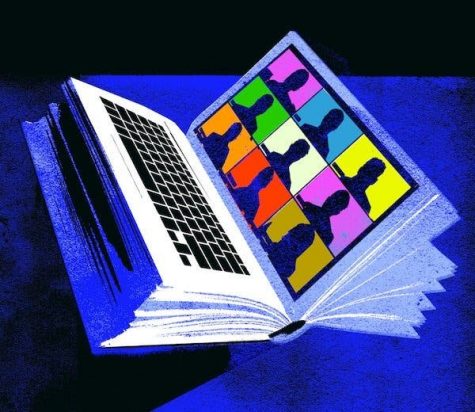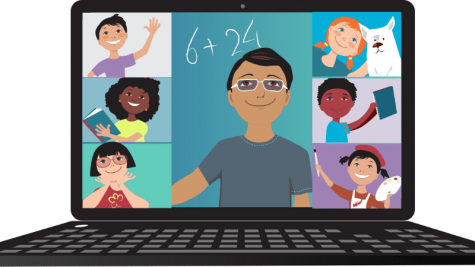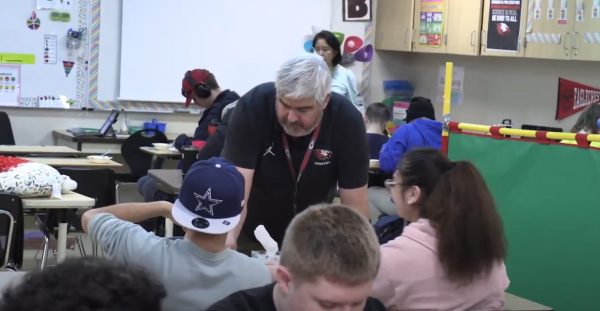The Toll On Teachers
Teachers and staff members point of views on the current situation, involving Covid-19 and the recent shift to full remote leaning.
With the quick shift to remote learning, students and teachers were forced into with Covid-19, teachers have had to adapt and learn as they go along to make this shift less stressful for the students at home, as well as manage their own mental health.
The current focus for teachers is just making sure all assignments are turned in and information about lessons are clear and direct, and many are leaning strongly on Schoology to help provide that. Gayle Hume, a social studies teacher, expressed, “The recent biggest challenge with remote teachers has been planning differently to teach shorter lessons in a way that engages the students we can’t see.” Finding new, creative ways to get students engaged in remote learning while still making sure they get the most out of it seems more important than ever.
Sources like The Hill acknowledge that teachers at a real disadvantage, stating, “Teachers need the right tools and support to teach online. Because of the COVID-19 pandemic, many have had to rethink their classes entirely and many are struggling under increased workloads while learning new techniques.” And now, teachers’ process of rethinking and the reconstruction of lessons is overseen by students and parents. So much work is going into these lessons, putting an enormous amount of stress on teachers.
“I’ve learned a ton of platforms I’ve never even heard of before this year, so the learning curve has been very steep,” Ms. Hume said, expressing the challenges of learning new tools this year. “I know the kids are in the same boat, and they’re having to balance different expectations from all of their teachers.” New and improved apps and platforms like Zoom, Microsoft Teams, and more are being invented daily to help with this transition of online learning. Learning new tools and skills is a key factor to create useful and impactful lessons for students from teachers.
“Since the pandemic, I feel like a brand new teacher again because everything about teaching is different this year!” Ms. Hume states. “The amount of time we’re spending remaking in-person work into remote or electronic work is pretty unreal, and coming up with ways for you to still work together in small groups or with another student without putting you at risk was tricky.” Hume emphasizes the point that she has noticed an extreme change and shift in students’ motivation and engagement this whole year, including before remote.
Andrea Rebert, an Eaglecrest counselor, has been a strong advocate for students reaching out for help and support in times where their mental health is at its lowest. Ms. Rebert states, “One of the biggest changes I’ve noticed with students is realizing how much they appreciate school as we knew it in years past.” From her own personal experience talking to students first hand, she has noticed that with the remote learning shift, students have become more grateful for the times they had in the school and learning environment since Covid.
“It’s really easy to take things for granted when they’re a part of everyday life,” Rebert continued. “And I think many students have realized that they were taking the structure and lessons of traditional school days for granted once hybrid and online learning started.
Along with school, Covid-19 has affected jobs and work environments all over the country as people are being laid off, getting fewer hours, and so much more. From the counselor’s point of view, their jobs haven’t changed much. Although, like so many other workplaces, the lack of face-to-face interaction is what makes the job harder.
“Counseling is all about building relationships, and when you can only see someone’s eyes, it’s difficult to read facial expressions and emotions,” Ms. Rebert states, explaining the recent struggles and difficulties she faces as a counselor. “We’ve had to get creative when we talk to students: going for walks in the hallway or outside, opting for meetings in larger conference rooms instead of our offices, having to meet virtually, even during hybrid learning.”

Students have been reaching out to teachers and counselors for support recently as a result of ongoing common concerns with regards to remote learning and Covid-19. One of students’ main concerns has been about getting their work done and achieving grades that they once had that they are and can be proud of.
Eaglecrest counseling staff stated, “The difference this year is that to achieve this, many students have seen a need to increase their skills for self-motivation, time management and reaching out to their teachers when they need something.” To improve these skills, it is sometimes necessary to push students outside their limits of comfort to make sure they are getting what they need to be successful. Counselors advise for communication with teachers, especially as teachers are waiting and expecting it.
The lack of communication between students and teachers is likely a result of the sudden switch to a new form of education. As teenagers were suddenly stripped of social interaction and the proper in-person help they need, they were forced to learn a whole new way of education in a short period of time. This caused panic and stress in lots of students, but also difficulties for teachers. Fortunately, we have teachers who are working hard to make sure students understand the assignments and are engaged even with the difficulties of remote learning.
“I get a lot of feedback from my students when we are in-person, so losing that during remote lessons has made it harder for me to modify a lesson to fit the learning needs of my students,” stated Mrs. Kesler, a physics teacher and science department coordinator. One of the biggest challenges with remote for teachers is planning around student feedback due to the lack of emotion and inability to see faces. Without feedback, teachers are unaware of how much students are actually understanding. With this comes the consequences of a lack of motivation, performance, and participation.
“The biggest challenge has been not seeing my students and not being able to see most of their thinking in real-time. I understand why most students are hesitant to have their cameras on and actively participate in class during remote learning, but it makes it very hard to teach if I can’t actually watch students work and assess their thinking in real-time,” said Mrs. Brewer. As an algebra teacher, Mrs. Brewer has made a huge impact on students’ ability to learn and comprehend math. Without student participation and motivation, Mrs. Brewer is unable to teach to her best abilities and she is not the only one.
“Attendance during remote learning is better than it has ever been and we’ve been seeing participation from some students who are normally very reserved. Unfortunately, others have decreased their participation at the same time,” said Kesler. Students who have been engaged during in-person learning are now barely keeping their heads above water. Just as students are struggling, so too are teachers, unable to teach the way they have always known with a new non-interactive system.
Without being able to see facial expressions, teachers can’t evaluate how students are doing. Cameras have always been allowed but not required. Teachers constantly encourage students to turn their cameras on during remote learning. Though most devices do have internally built cameras, not all students and staff have the proper technology to be able to attend class and complete or share all assignments. Wi-Fi has been the biggest issue with most students and staff.
“It can be very frustrating for both my students and me when the internet connection is poor. Even if it’s a great lesson it doesn’t do anybody any good if students are spending most of their time trying to log in,” said Mrs. Kesler. Students are often getting kicked out of classes and being locked out in the waiting room, along with experiencing constant connection and audio issues. Other students are unable to access classwork while on the call. This causes drops in students’ participation and completion, which all gets added to the one thing students stress about most: the grade book.

Aside from the technology issues during remote, teachers are always having struggles mentally. With remote comes a lot of time to help students who are struggling with this learning style. Lots of teachers are taking out time from their personal days to work with students.
“It is hard to ‘turn off’ my brain when the workday is done. Since I’m working from home, there isn’t a physical barrier between me and work anymore and it can be hard to be present with my family when I’m thinking about work,” Kesler said. Teachers are well aware of the current day struggles of education. Just like for students, the remote system is new to teachers. Without prior knowledge, it is almost impossible to smoothly switch the lifestyle of education.
“Teachers are doing their best. Teachers have received a kit of information all at once with very little time to process that information and do our job well. We have also gotten conflicting messages at this time from all levels of leadership in the second school district, and it’s hard to plan for something and communicate that clearly to students when things are frequently changing,” Mrs. Brewer said. “I feel like I’m not a great teacher this year and I feel guilty that my students are not getting the best version of me.”
Mental health has become a greater struggle not only for students but for teachers and staff as well. Without the hard work and dedication of teachers, students would be doing much worse. Considering the district had to quickly switch to remote with no knowledge of exactly what was going to happen, students and staff have been on their A-games, putting in the effort to maintain good grades while also maintaining time management and stable mental health. As everybody becomes more familiar with and aware of remote learning during this pandemic, students and staff should see a change in the education system once they develop more knowledge and plans.
Rhyan Herrera contributed to this article.

Karina Gofshteyn is currently a Junior at Eaglecrest and this is her third semester on staff. Karina enjoys working with opinion stories with a wide range...






